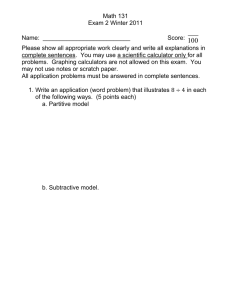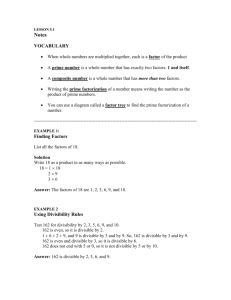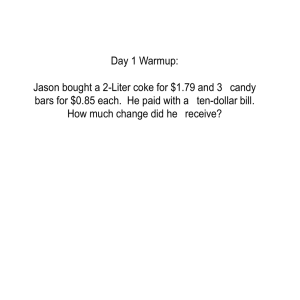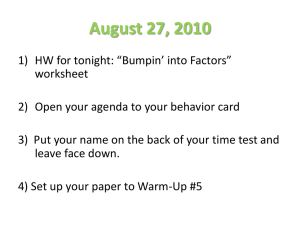Math 137 Exam 3 Review Problems - Fall 2008
advertisement
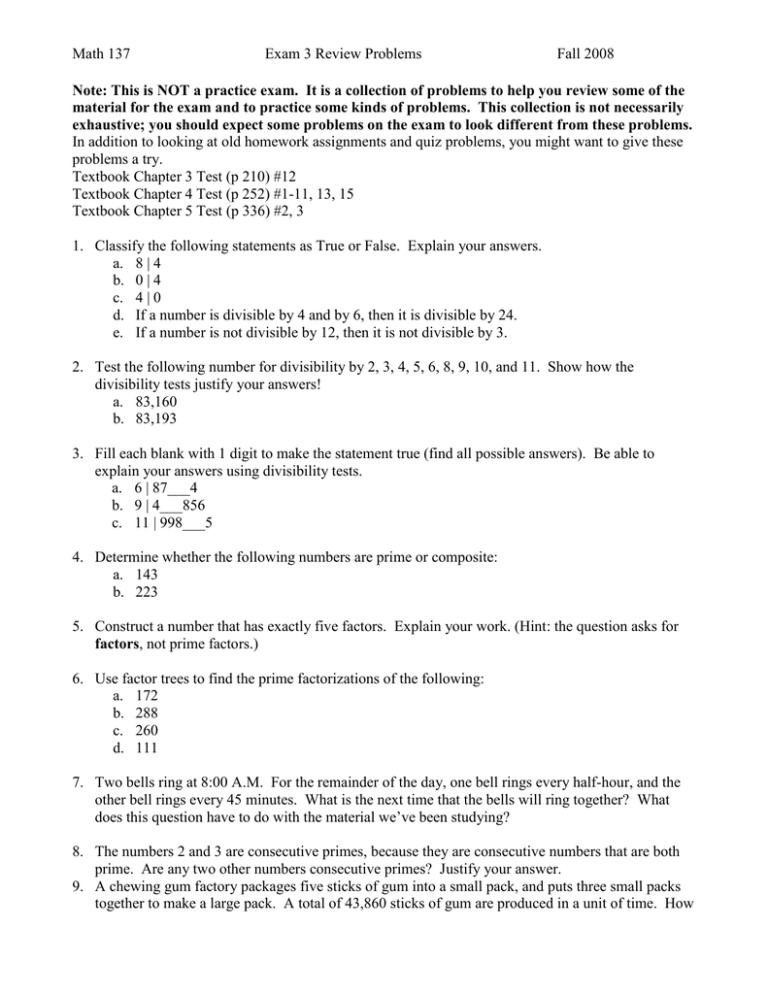
Math 137 Exam 3 Review Problems Fall 2008 Note: This is NOT a practice exam. It is a collection of problems to help you review some of the material for the exam and to practice some kinds of problems. This collection is not necessarily exhaustive; you should expect some problems on the exam to look different from these problems. In addition to looking at old homework assignments and quiz problems, you might want to give these problems a try. Textbook Chapter 3 Test (p 210) #12 Textbook Chapter 4 Test (p 252) #1-11, 13, 15 Textbook Chapter 5 Test (p 336) #2, 3 1. Classify the following statements as True or False. Explain your answers. a. 8 | 4 b. 0 | 4 c. 4 | 0 d. If a number is divisible by 4 and by 6, then it is divisible by 24. e. If a number is not divisible by 12, then it is not divisible by 3. 2. Test the following number for divisibility by 2, 3, 4, 5, 6, 8, 9, 10, and 11. Show how the divisibility tests justify your answers! a. 83,160 b. 83,193 3. Fill each blank with 1 digit to make the statement true (find all possible answers). Be able to explain your answers using divisibility tests. a. 6 | 87___4 b. 9 | 4___856 c. 11 | 998___5 4. Determine whether the following numbers are prime or composite: a. 143 b. 223 5. Construct a number that has exactly five factors. Explain your work. (Hint: the question asks for factors, not prime factors.) 6. Use factor trees to find the prime factorizations of the following: a. 172 b. 288 c. 260 d. 111 7. Two bells ring at 8:00 A.M. For the remainder of the day, one bell rings every half-hour, and the other bell rings every 45 minutes. What is the next time that the bells will ring together? What does this question have to do with the material we’ve been studying? 8. The numbers 2 and 3 are consecutive primes, because they are consecutive numbers that are both prime. Are any two other numbers consecutive primes? Justify your answer. 9. A chewing gum factory packages five sticks of gum into a small pack, and puts three small packs together to make a large pack. A total of 43,860 sticks of gum are produced in a unit of time. How Math 137 Exam 3 Review Problems Fall 2008 can you use divisibility rules to decide whether a whole number of full large packs are produced in that time? Do it! 10. A stamp collector has 280 stamps from North America and 264 stamps from South America. The collector wants to place the same number of stamps on each page of a large album, but he does not want to mix the stamps from different continents. What is the greatest number of stamps the collector can place on each page? How many pages would the book have? What does this question have to do with the material we’ve been studying? 11. Solve the following: a. –6 – 2 = b. 8 – (–1) = c. –23 + 43 = d. –4 × –8 = e. 16 × –3 = f. 408 ÷ –3 = 12. A sports announcer kept track of the yardage gained and lost by the Boilermakers over a series plays in a football game. The announcer’s notepad showed the following : +8, –3, +34, +2, –14, 0, –1. What was the net yardage gained or lost of this series of plays? 13. Give three equivalent fractions for each of the following: a. 6 b. 0 c. 15 7 14. If 15. If 25 100 represents 3 , draw and explain a picture to represent 1. 5 represents 3 , draw and explain a picture to represent 9 . 5 10


